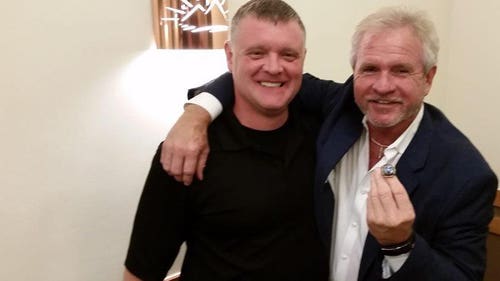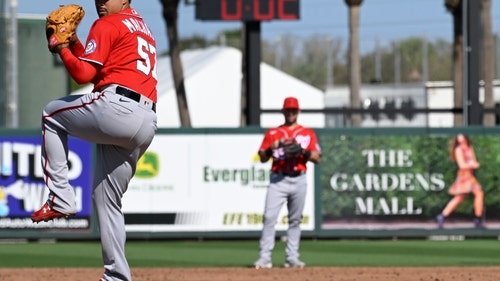
Yankees enter spring without controversy
One by one, the Yankees are arriving at Camp Steinbrenner. For the first time since Paul O’Neill roamed right field, they have a title to defend.
The clubhouse is getting busier, save for the non-appearance of a longtime pinstriper: His name is Perpetual Controversy. A springtime fixture for so many years, he’s a no-show now.
“It was a very quiet winter,” Yankees manager Joe Girardi said Wednesday.
Girardi wasn’t inviting a jinx. He was stating a simple fact. After winning a well-deserved World Series on Nov. 4, some stretches of the Yankees’ offseason were downright boring.
As achievements go, that was nearly as impressive as beating the Phillies.
No steroid revelations. No shakeups in the front office or field staff. No A-Rod bombshells, unless you count a reported starlet switcheroo. (And I don’t.) Add a Curtis Granderson and Javier Vazquez here, lose a Hideki Matsui and Johnny Damon there, and this was a pretty ordinary offseason — even by outside-the-Bronx standards.
But don’t fret. With pitchers and catchers beginning their workouts, life will get complicated for the Yankees soon enough. With so many stars, watched by so many eyeballs, that is inevitable.
The Yankees have a good chance to repeat — to the extent that any champion does. They are a professional outfit from top to bottom, and Girardi will have his players ready.
Derek Jeter and Mariano Rivera are coming off great, age-defying seasons. Alex Rodriguez should be emboldened by his redemptive October. Mark Teixeira, CC Sabathia and A.J. Burnett know what to expect in New York.
Yet, there are reasons that a full decade has passed without the Yankees (or anyone else) winning consecutive titles: Baseball happens, and not even a $200 million payroll can stop it.
I visited Steinbrenner Field on Wednesday, and here are the half-dozen questions that stayed with me after I left -- more so than the ordinary-for-spring-training issue of whether Curtis Granderson or Nick Johnson will bat second. .
1. Will the bill from October arrive in the second half of this season?
The Yankees may be inclined to ration every sunflower seed toss by Joba Chamberlain, but they had no trouble switching off the governor on their veteran starters when it mattered most.
Girardi’s team played 15 games in the 2009 postseason, and he handed the ball to Sabathia, Burnett or Andy Pettitte in every one. The Yankees won, so the gamble was well worth it. But I won’t be surprised if there is some year-after-the-champagne fatigue.
It happened to Cole Hamels last year. By the end of the postseason, the Phillies’ erstwhile ace was weary, ineffective and looking forward to some downtime. Any armchair sports psychologist could make the diagnosis: The guy was tired.
I don’t necessarily think that one Yankee is a stronger burnout candidate than the other two. But the evidence is there if you want to see it. When including the postseason, Sabathia (266 1/3) and Burnett (234 1/3) set career highs for innings pitched. Pettitte turns 38 this year, and a sore shoulder forced him to take extra rest late last year.
Girardi said Tuesday that he will manage his starters’ workload carefully this spring, as a result of the short offseason. That’s a good precautionary step. Still, he can’t control two of the biggest factors: age and luck.
2. The issue that won’t go away: Joba or Phil?
So here we are again, asking the essential questions of where, when and how much the prized right-handers will pitch in 2010.
Chamberlain and Phil Hughes are the chief contestants for the fifth starter’s job, and Girardi said Wednesday that he’s anticipating a “great competition.” He made sure to mention Alfredo Aceves, Chad Gaudin and Sergio Mitre, too, but we all know where the media and fan focus will be.
If the Yankees ultimately view the two as being in a virtual tie, they should give the nod to Hughes. The reason: They already know what Chamberlain can do when he’s in the rotation over a full season. Unfortunately for them, that involved a 4.75 ERA in 2009 — slightly higher than Brian Bannister’s mark.
3. The Yankees effectively swapped Damon, Matsui and Melky Cabrera for Curtis Granderson, Nick Johnson and Randy Winn/Marcus Thames. Net positive or negative?
Damon still hasn’t put ink to paper, and it’s apparent that he should have made more of an effort to sign with the Yankees when he still had the chance. Oh well. The Red Sox-Yankees rivalry will go on without him for the first time since 2001.
Girardi sounded optimistic about the lineup when he was asked Wednesday, and he has every right to be. Johnson’s patient approach and left-handed power should make him a great fit. As the designated hitter, he has a better chance of staying healthy than during his years in the National League.
I also expect Granderson to reach 35 home runs in his first year as a Yankee. Add it up, and a second straight 900-run season isn’t out of the question.
4. Does it matter that Jeter, Rivera, Pettitte and Girardi have expiring contracts?
The Yankees have maintained the same policy for several years now: They wait until player contracts expire before negotiating new deals. The same holds true for Girardi and even general manager Brian Cashman.
A number of Yankee notables will take their turn facing the uncertainty this year. And at least where the players are concerned, the team is correct to stick with the letter of its law.
The policy is in place so the Yankees aren’t constantly negotiating with their millionaire employees. I get it. In this case, the practice offers a side benefit: There is no rush to meet the players’ market price after a world championship season, without knowing whether the veterans will stay healthy through this year.
5. Catcher Jorge Posada turns 39 in August. How durable will he be?
Over an eight-year span from 2000 through 2007, Posada played in an average of more than 140 games per year. But he appeared in 51 and 111, respectively, during the last two.
Posada has spent time on the disabled list during each of the last two seasons — in 2008 because of shoulder surgery, in 2009 because of a strained hamstring. Now, veteran Jose Molina isn’t around as the backup.
Posada, a valuable switch hitter, is still very productive when he’s in the lineup. He said Wednesday that his shoulder “feels good” after the offseason. It will be up to Girardi to keep him healthy without cutting into too many of Johnson’s at-bats as the designated hitter.
6. Vazquez pitched through pain (and struggled) down the stretch in 2004. How much better will he be in a second go-round as a Yankee?
Yankees fans probably remember Vazquez mostly for his poor performance in Game 7 of the ’04 American League Championship Series. But they will see a better, more mature version of the right-hander in 2010.
Vazquez looked and sounded confident while speaking with reporters at his locker on Wednesday. And that shouldn’t come as a surprise: Ozzie Guillen, then his manager, called out Vazquez for his lack of big-game credentials in 2008, and he responded by putting together a terrific season for the Braves last year.
Posada believes the Yankees are now getting Vazquez “at his peak.” I agree. And given the workload shouldered by the other veteran starters last year, Vazquez should be ready to throw a lot of pitches in the coming months.
If he performs well enough, we might be wondering next spring about how he bounces back from an October of chilly work.










